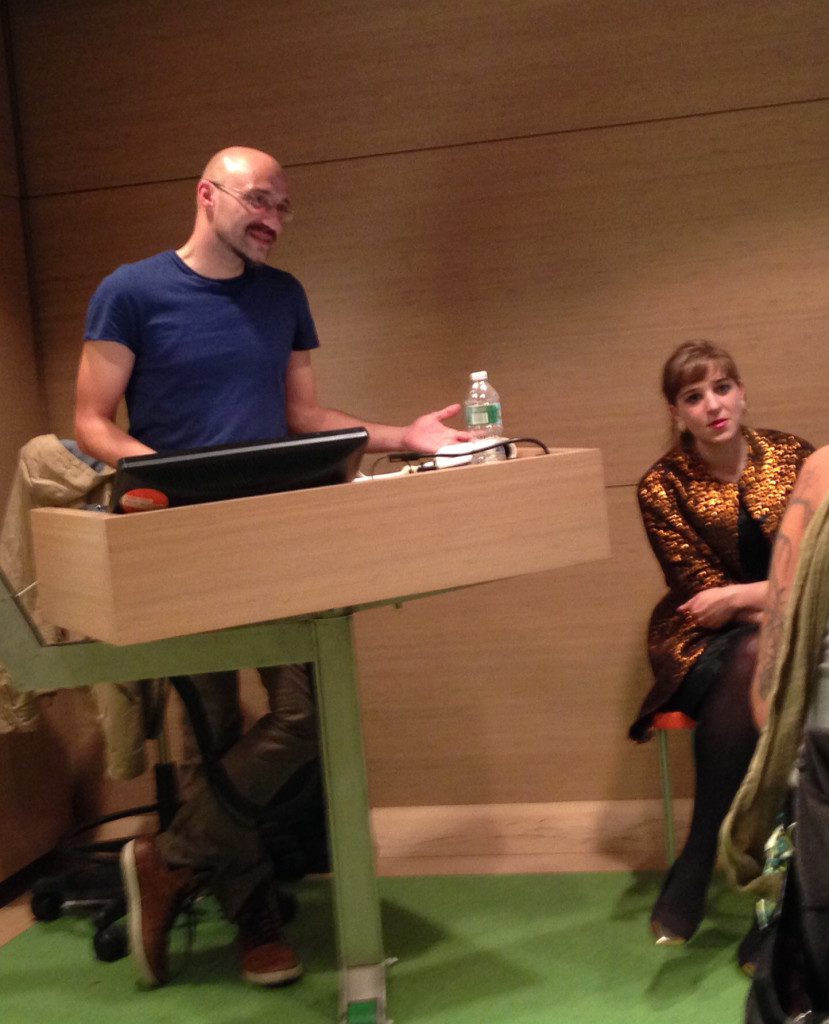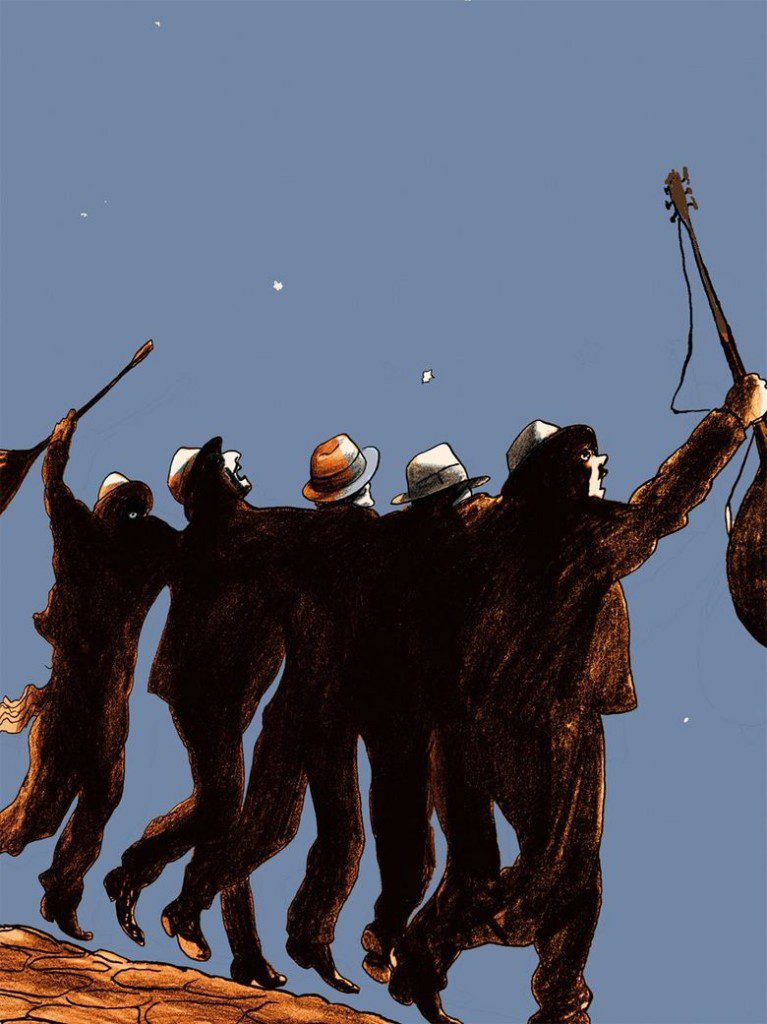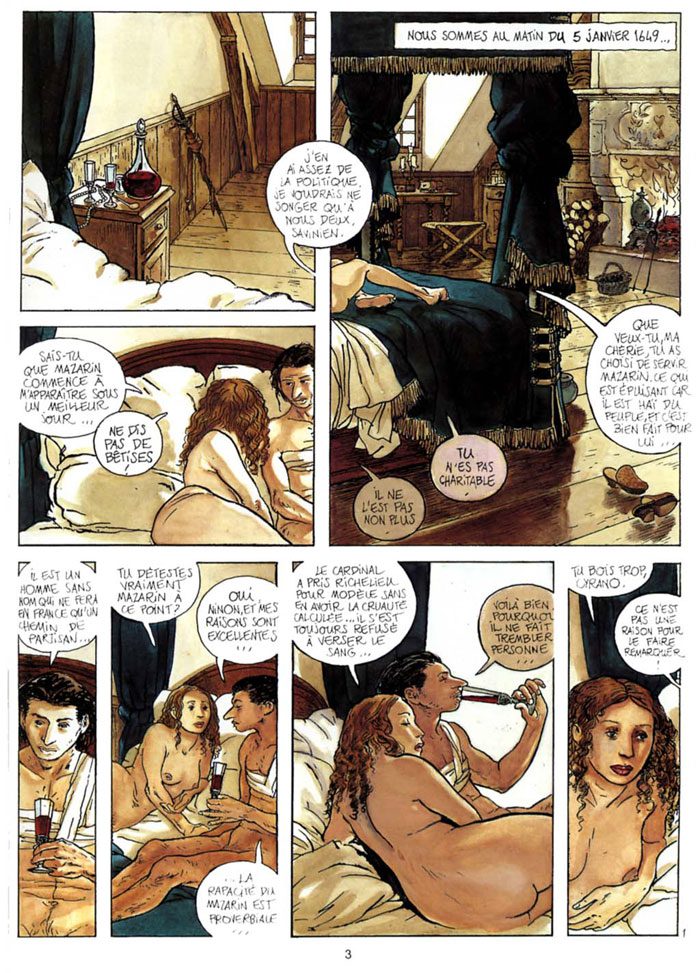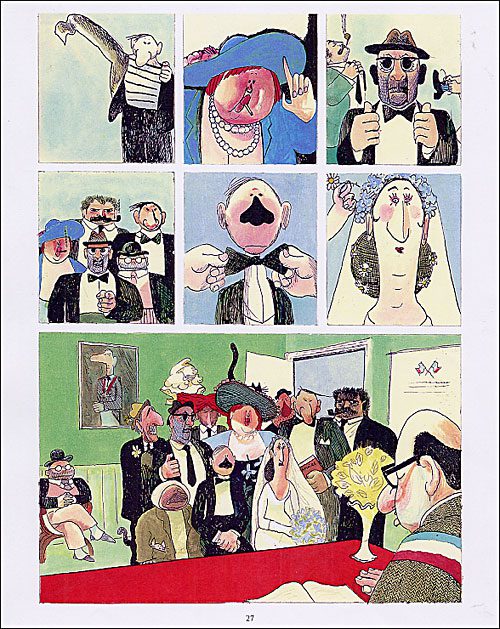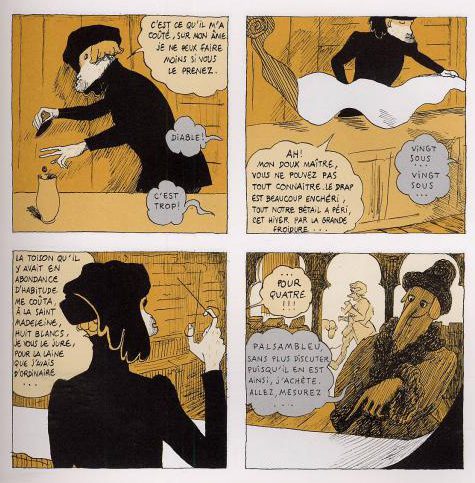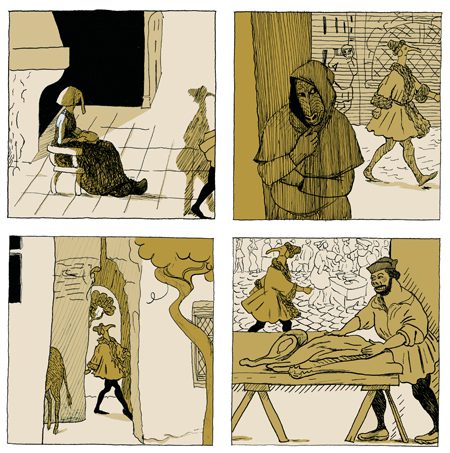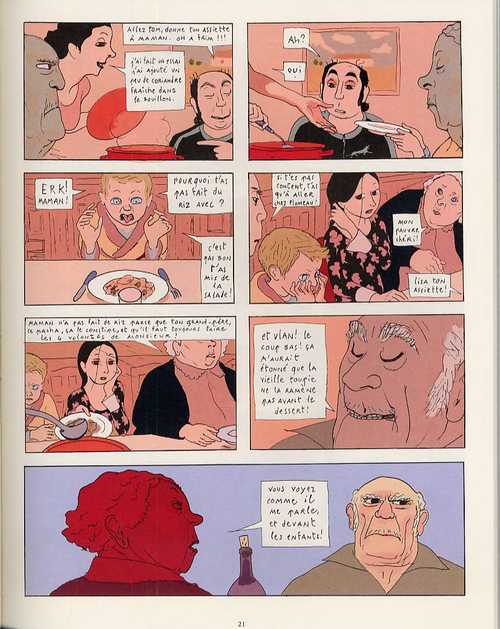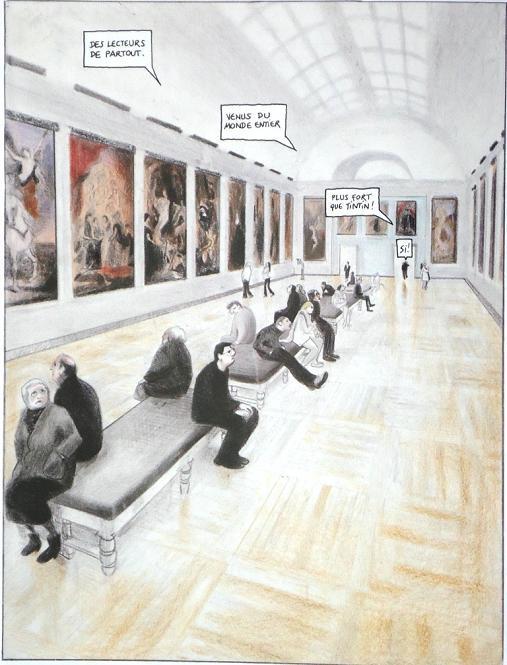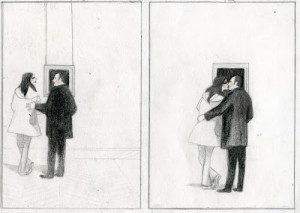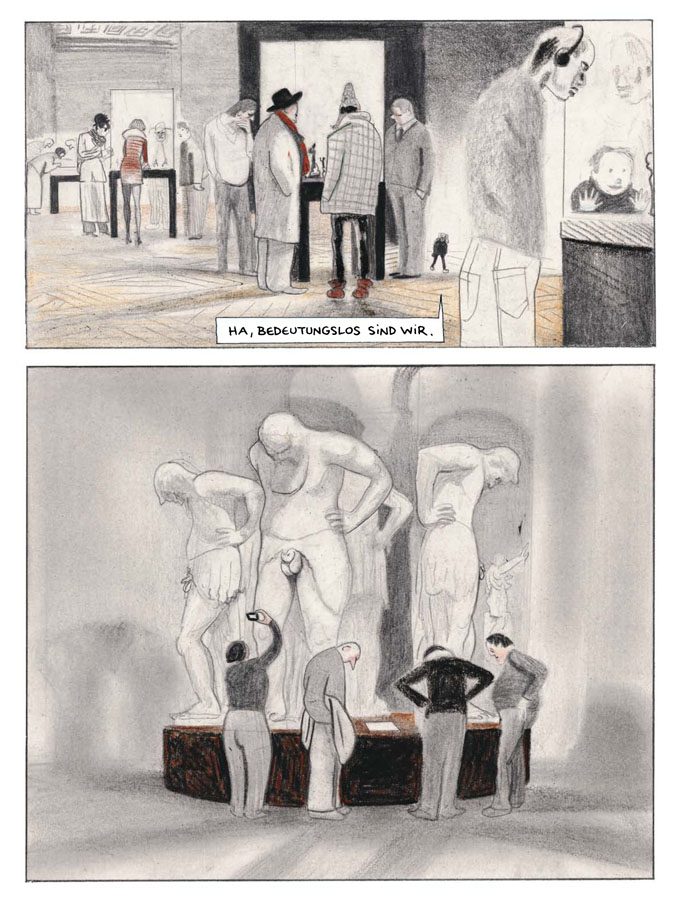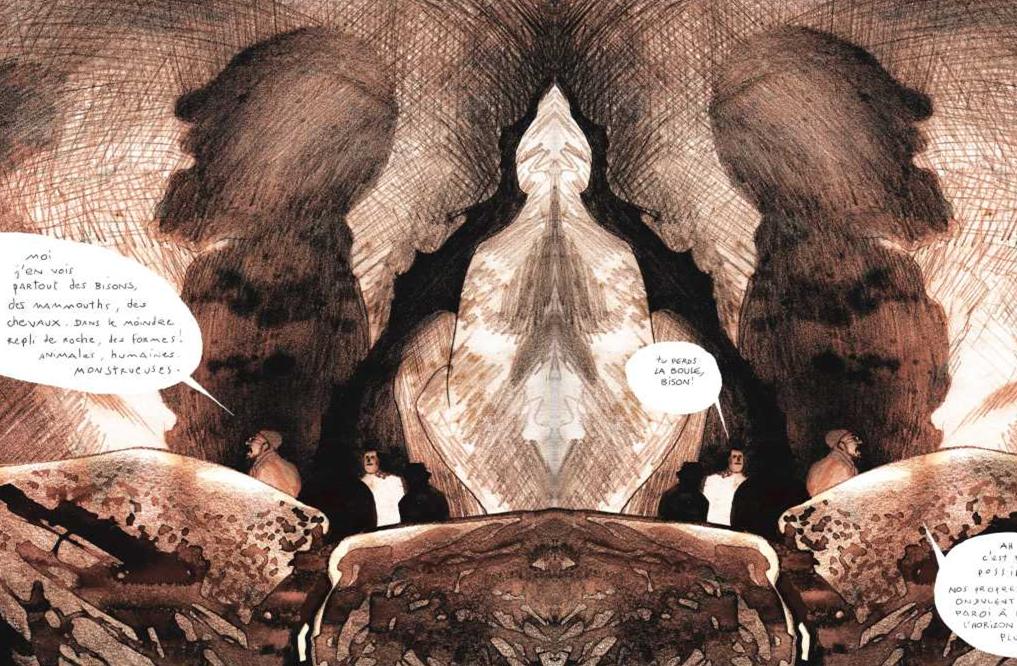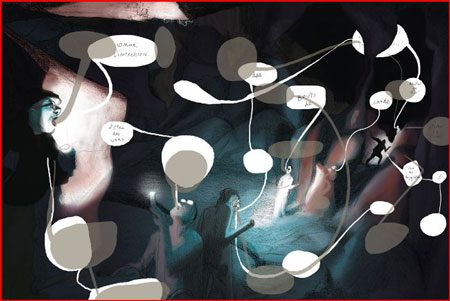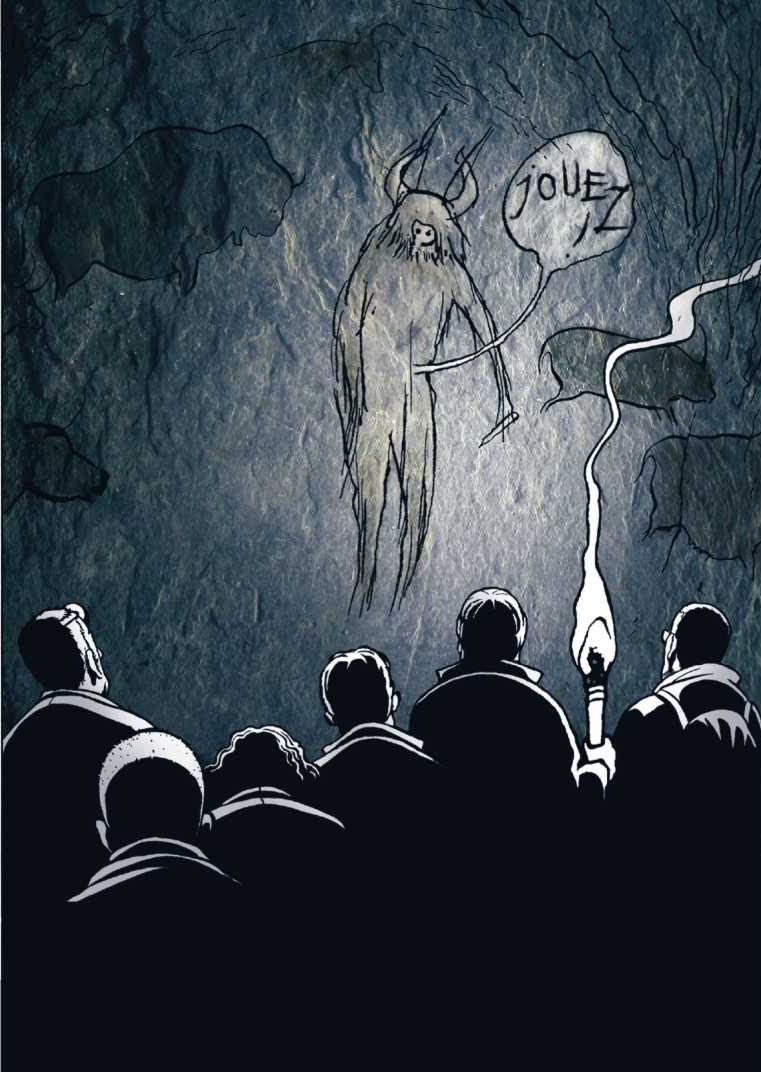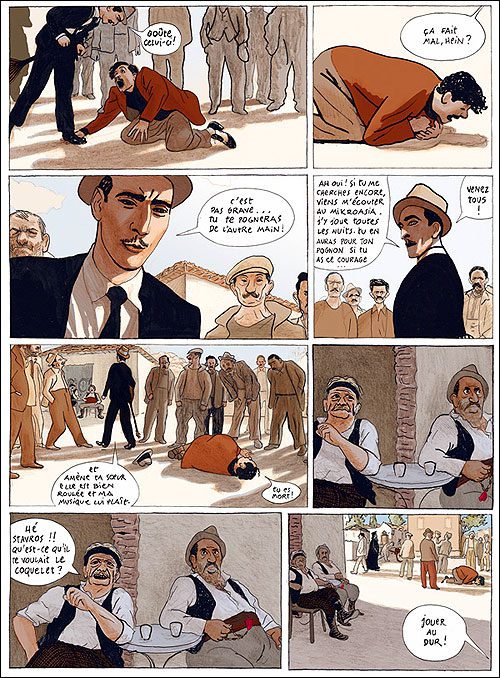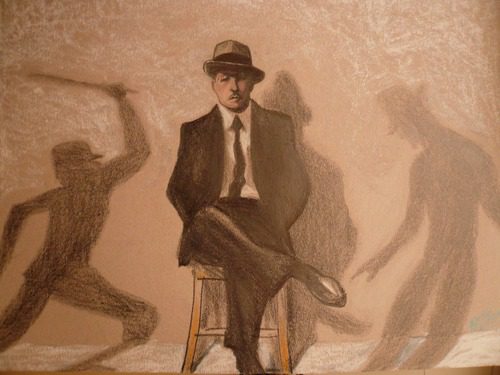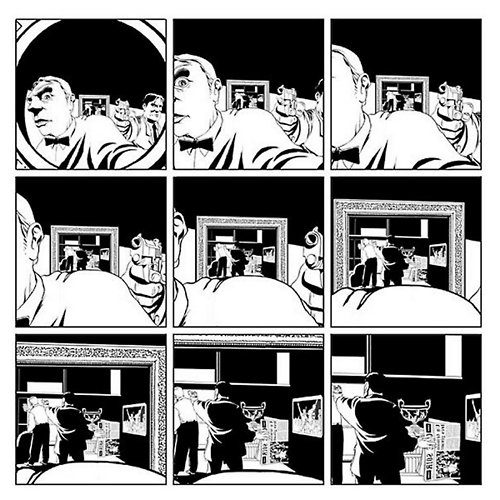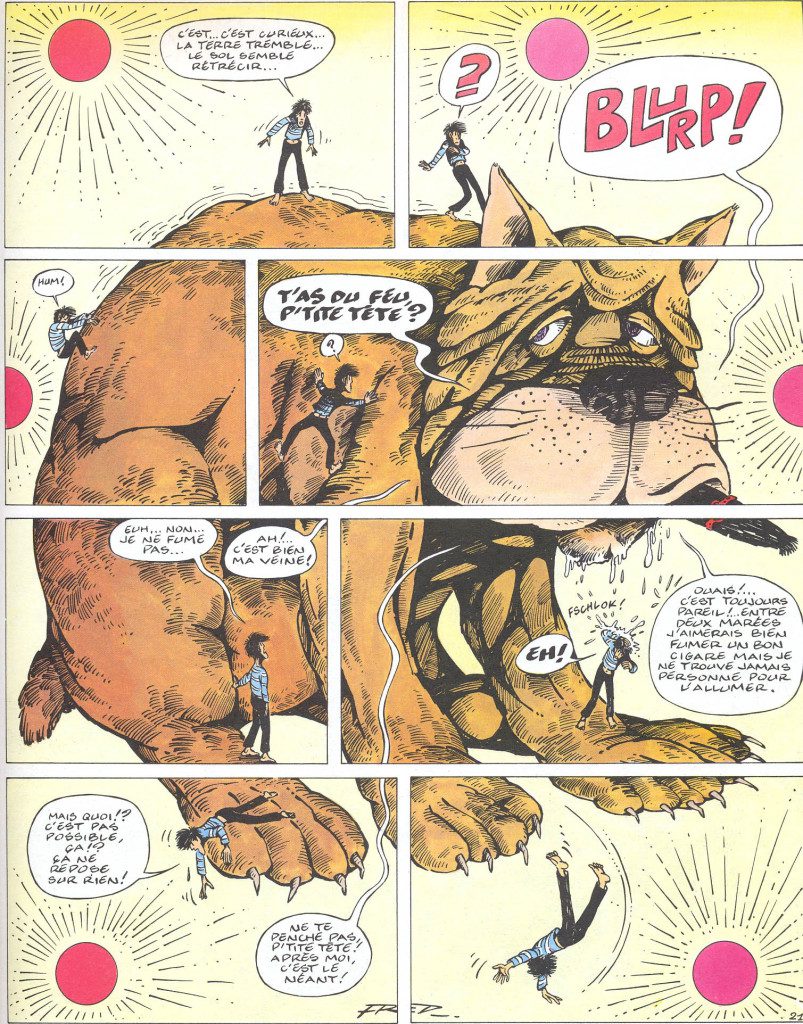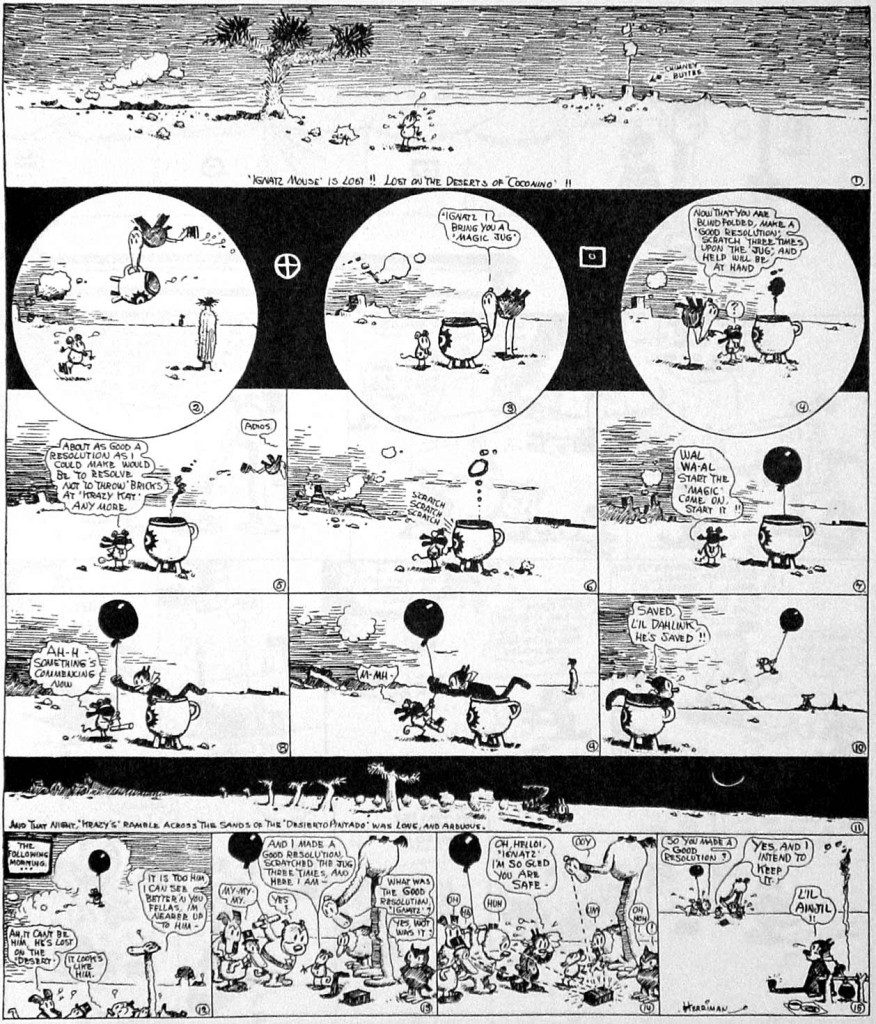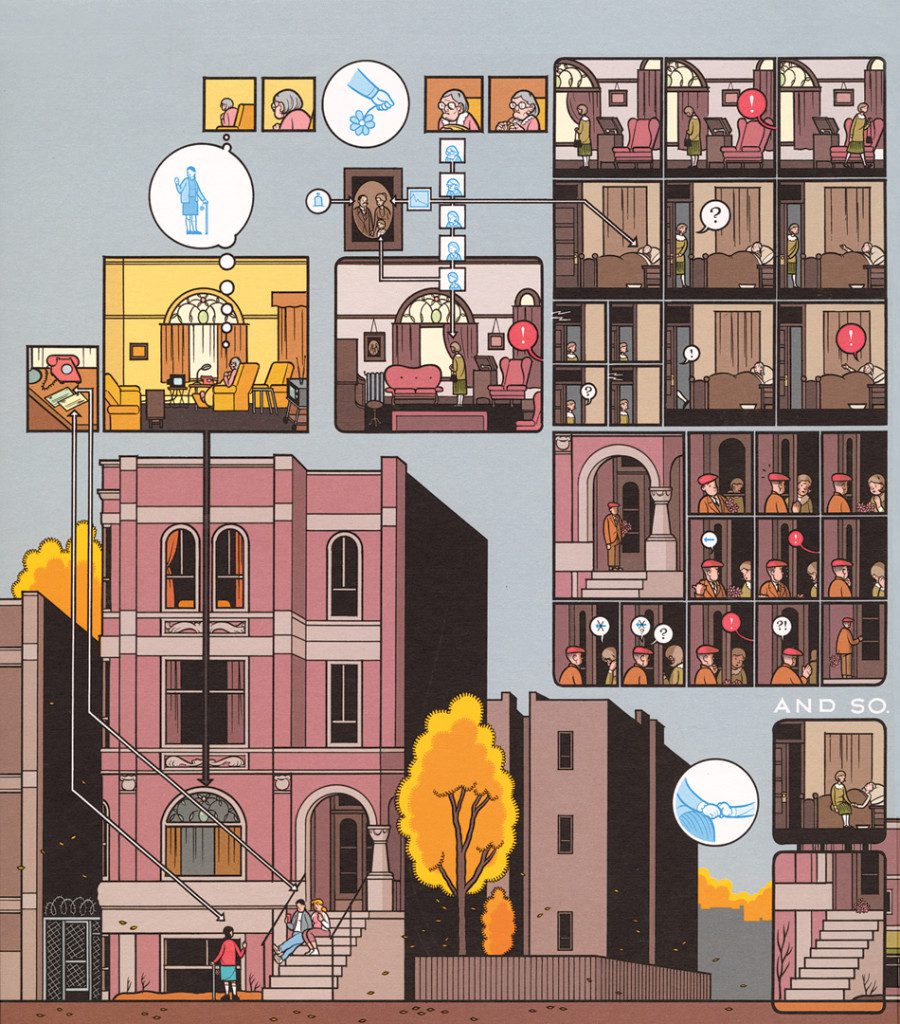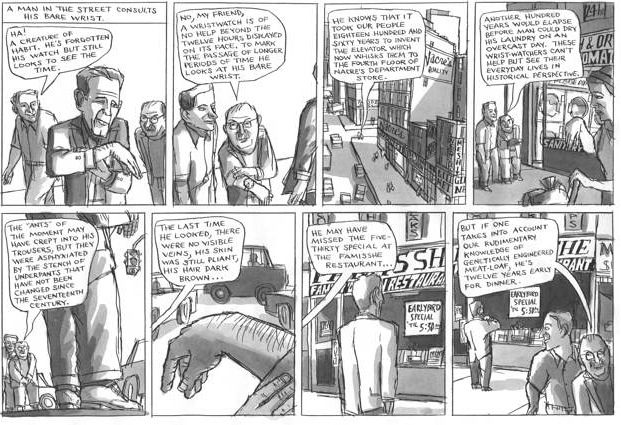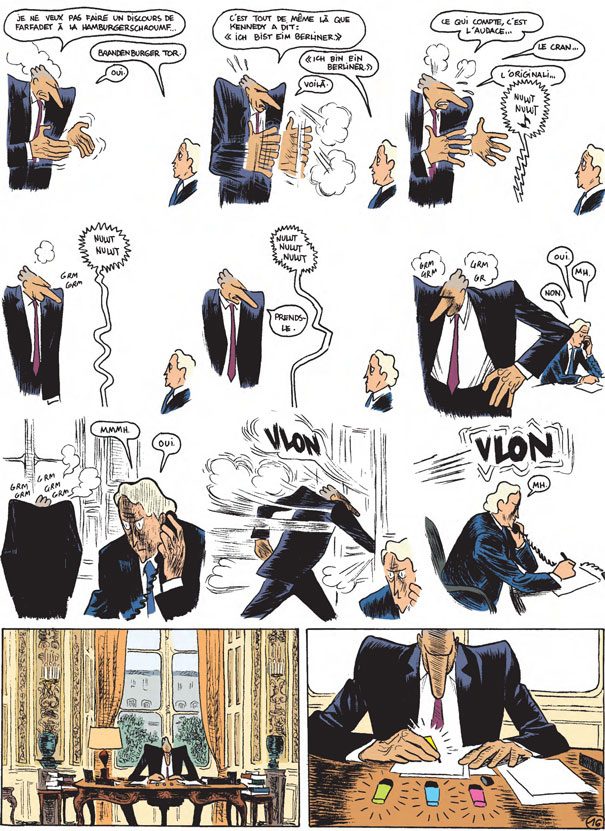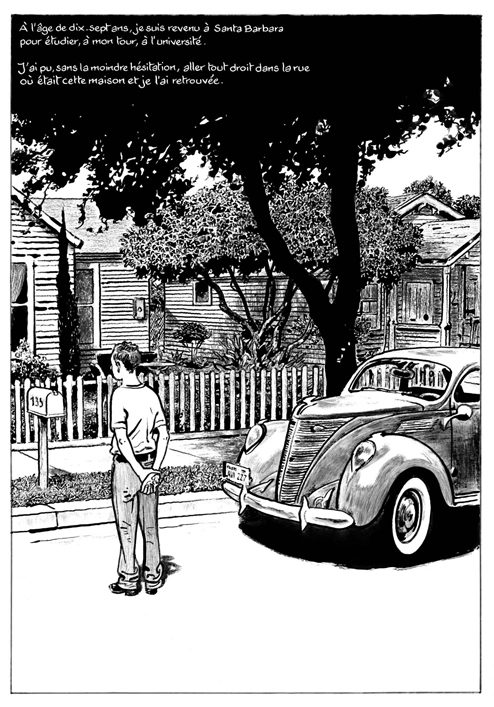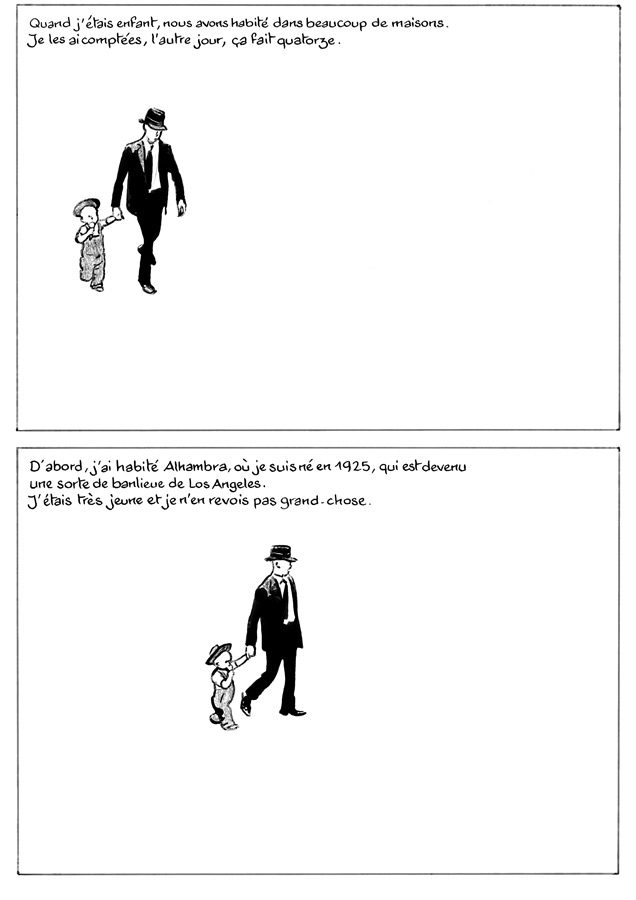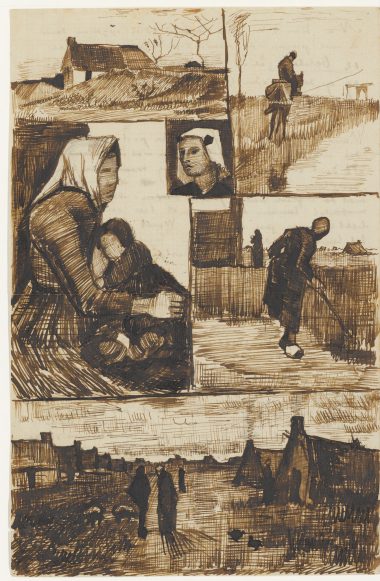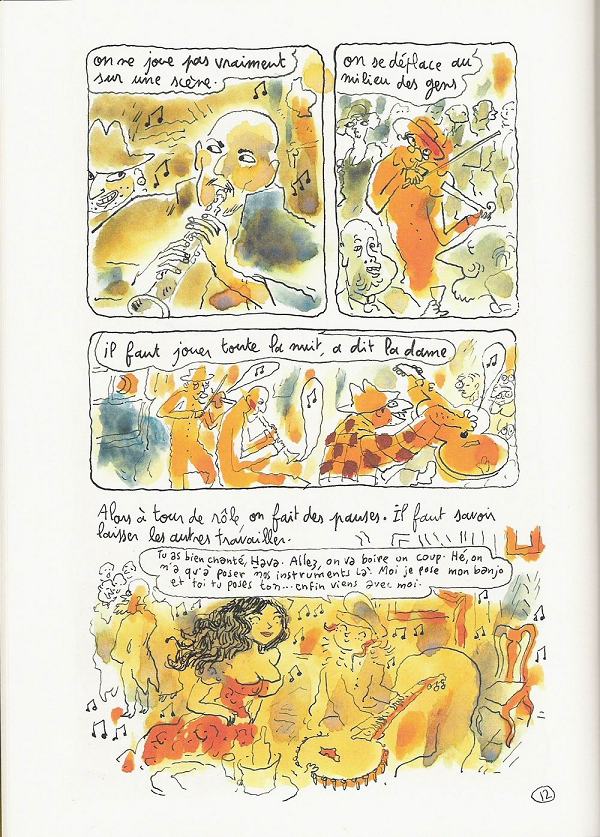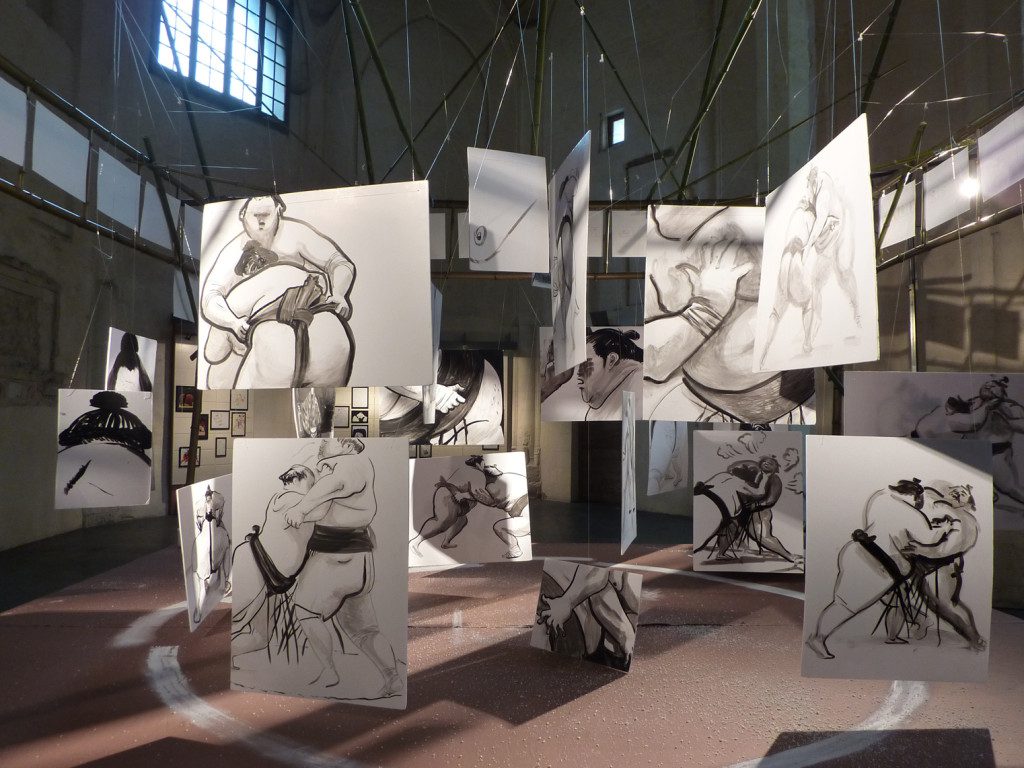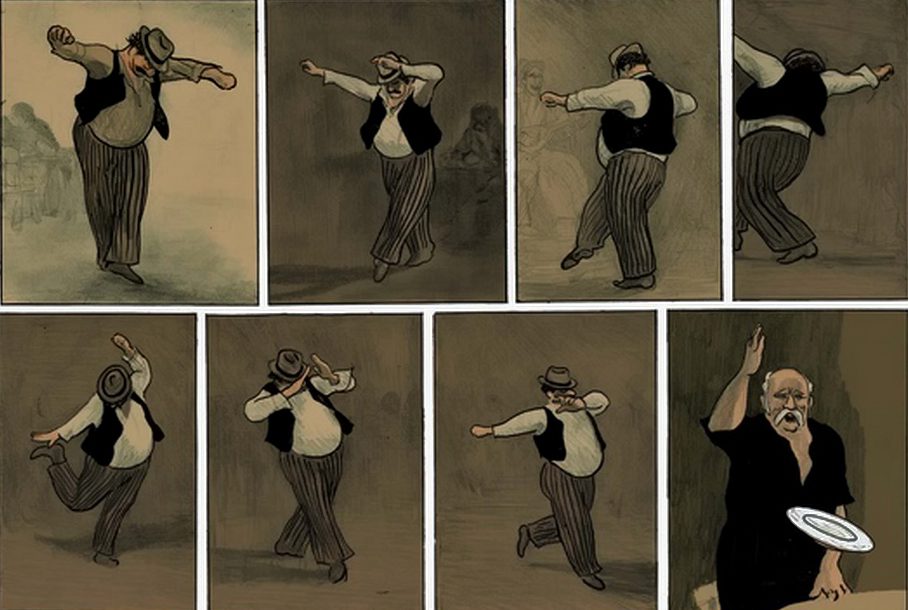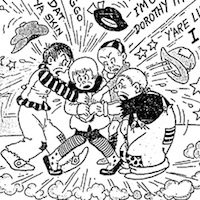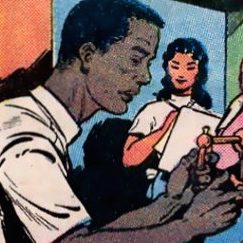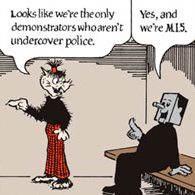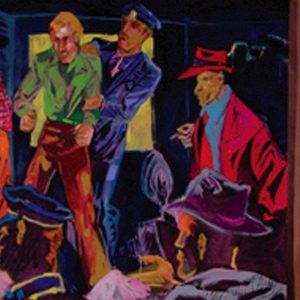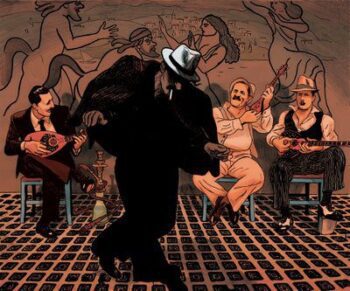
The New York Comics & Picture-Story Symposium is a weekly forum for discussing the tradition and future of text/image work. Open to the public, it meets Monday nights at 7-9pm EST in New York City. Presentations vary weekly and include everything from historical topics and technical demonstrations to creators presenting their work. Check out upcoming meetings here.
French cartoonist David Prudhomme presented at this week’s comics symposium, speaking about his work and the way it plays with narrative time. A graduate of the Arts School of Angoulême, Prudhomme has worked on many comics, including the Ninon Secrète series, La Marie en Plastique, and La Farce de Maître Pathelin. The English translation of his most recent book, Rebetiko, a winner of the Angoulême Prix Regards sur le Monde, debuts this month. Prudhomme split his talk into two sections: a chronological presentation of his work and a discussion about how comics play with time. Illustrator and symposium member Lea Mairet acted as a translator.
Arranging the first part of his talk chronologically let Prudhomme demonstrate how his comics style evolved and let him show how comics became part of his life. Like many cartoonists, he was a shy kid and started drawing at an early age. Growing up in a small village in Bordeaux, he had the luck to meet someone who encouraged his art. When he was fifteen, in another stroke of luck, he met French comics legend Jean Giraud/Moebius. He studied the classical techniques of drawing (perspective, anatomy, etc.) and arrived at the Arts School of Angoulême ready to break all the rules he had learned. It was hard to negotiate both revolting against artistic standards and paying homage to them, but he tried to find a balance between them. His first big project, making the art for a series about the Musketeers, Ninon Secrete, took twelve years and saw his style change from more classically influenced to looser and more experimental.
During those twelve years, Prudhomme met other cartoonists, found new influences, and drew his own self-published comic. He also made a graphic adaptation of a George Brassens novel, La Tour des Miracles, with Etienne Davodeau. “[A] novel was a field [in which] you could explore more. A space to run with [our] own creativity,” he said. This first story was rich with themes Prudhomme would return to over and over again throughout his career: “a community that has its own rules,” people on the margins of society, and laughing “about the world in general.” He became fascinated by street artists and by how the need to make art existed simultaneously with a driving need for survival. He also took a trip to Japan and collaborated with eight other French authors and eight Japanese authors on a project inspired by their travels.
His next big project was La Farce de Maître Pathelin, a popular medieval farce written by an anonymous author in the 15th century. “The story is based on language,” or specifically the games the characters play with twisting language into lies, metaphors, and jokes. Prudhomme also experimented with the composition and point of view: he came up with many different ways to draw the action within a square four-panel layout. “The medium is as important as the story,” he said, noting how he wants to really use and explore the power of the comics medium in his work. He then moved on to an apocalyptic farce, Port Nawak, created with Jean François Hautot, and Le Marie en Plastique (with Pascal Rabaté), a story about tensions among a large family over a religious phenomenon.
In 2012, his La Traversée du Louvre was published: a book of colored pencil drawings of Louvre visitors. Lush, clever, and observant, his drawings capture the funny way visitors behave and their relationship with the art around them (whether they are aware of it or not).
On one page, he captures the faces of a massive crowd staring at The Mona Lisa and completely ignoring the enormous Wedding Feast at Canna painting behind them. A pile of tourists collapsed on benches accidentally blend into the painting The Raft of the Medusa behind them. People kiss. People bend backwards to see the ceiling, highlighted by a shaft of sunlight. Many take photos with their phones. He used colored pencils to emphasize the idea of sketches, blurred moments, and unfinished scenes.
He laughed at how at the end of the book, when he left the museum, the streets were plastered with large presidential election posters that were defaced and collaged into funny new images. So even after leaving the Louvre, he was surrounded by art and artistic play. The theme of walking (going through the museum) is another prominent theme in his work, one that he continued in his next project, Rupestres!
Rupestres! is a book by Prudhomme, Emmanuel Guibert, Étienne Davodeau, Marc-Antoine Mathieu, Pascal Rabaté, and Troub’s about their visit to caves with prehistoric drawings. For Prudhomme, the project inspired some intriguing questions about time and drawing. The time it took the artists to draw the animals on the wall, the movement and time implied by the drawing, and how long it possibly took for the artists to plan their drawings. They figured out that one large composition with many animals started with the drawing of a horse, then the other animals were added around it and partially overlapped it, as if the animals were running around this horse. Some of these cave paintings weren’t made to be seen, either—they were just made to be drawn.
“One thousand years ago, people had this need for the action of drawing,” Prudhomme marveled. “One cave drawing is maybe nine lines that took ten seconds, but how much preparation went into that?” He put aside this theme of time to describe his latest book, but picked it up again later.
Rebetiko, his most recent major work to date, is a graphic novel following one night in the lives of a group of Greek musicians. Revisiting themes that permeate his earlier works (a community at the margins of society), Prudhomme focused on musicians returning from Turkey with a new music style blending Greek and Ottoman traditions.
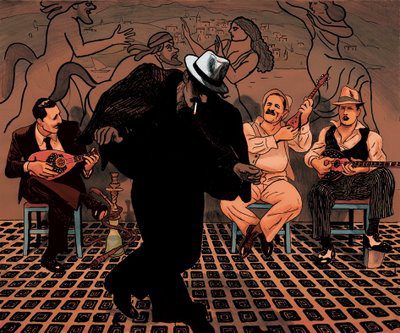 In 1936, when this book takes place, this was considered underground and potentially subversive (the dictator, General Metaxas, frowned on this style), but nevertheless they revel in their music. He based much of the story on historical research, but stressed it was fiction mixed with fact. He colored this book in Photoshop and showed us the black and white drawings before and after they were colored.
In 1936, when this book takes place, this was considered underground and potentially subversive (the dictator, General Metaxas, frowned on this style), but nevertheless they revel in their music. He based much of the story on historical research, but stressed it was fiction mixed with fact. He colored this book in Photoshop and showed us the black and white drawings before and after they were colored.
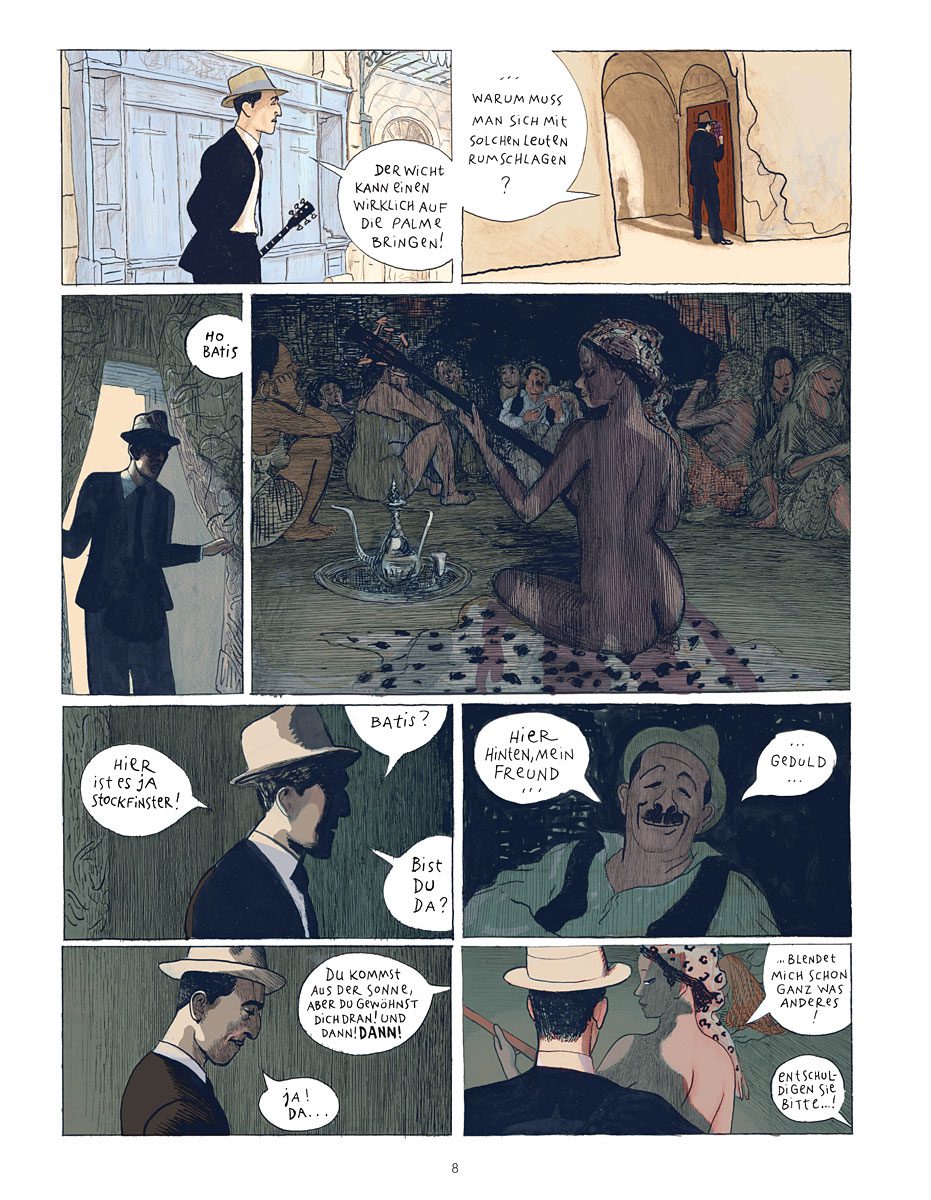 Prudhomme then launched into his discussion about time in art and storytelling. Circling back to Rupestres as an example, he said, “as artists, sometimes we need to rest between two lines, but it is possible to make a drawing in one hour.” Drawings are “sometimes a time machine,” because they link your experience of them with the experience that existed making them and because they contain so many layers of time all at once.
Prudhomme then launched into his discussion about time in art and storytelling. Circling back to Rupestres as an example, he said, “as artists, sometimes we need to rest between two lines, but it is possible to make a drawing in one hour.” Drawings are “sometimes a time machine,” because they link your experience of them with the experience that existed making them and because they contain so many layers of time all at once.
The difference between comics and the cave paintings is: in comics, it’s more difficult to think on how long it actually takes to make a piece of art because the process is broken into so many steps: sketching, penciling, inking, and coloring. In a cave, there’s just the drawing—you “see” the time it took to make it.
Also, in comics, there’s the added factor of the time it takes to read a work. Prudhomme cited Marc-Antoine Mathieu’s 3 Seconds as an exercise in different ways of measuring time. The book is about a short slice of time, but it is slowed down into how one sight travels to the eye, to a reflection and then back and so forth, gradually taking in more and more detail. One also has to consider the time it took to make the actual drawings (considerably more than it takes to read the book or for the book’s events to transpire).
Comics are one of the only art forms that let us approach an overall page or spread and its constituent parts simultaneously. We get “a parallel confrontation as a reader and as an artist,” and the comic becomes “a place where time is juxtaposed with itself.” Prudhomme then showed images by artists who play with time in their drawings and storytelling: Fred Philemon, Lyonel Feininger, George Herriman (Prudhomme especially highlighted Krazy Kat), Chris Ware, Art Spiegelman, Ben Katchor, Emmanuel Guibert, Blutch, Christophe Blain, Eadweard Muybridge, Lewis Trondheim, Ruppert & Mulot, Hergé, Van Gogh (check out his “comics” sketch in a letter), and Eric Lambé.
Feininger and Herriman played with the gutter space to show jokes or action between the panels. Chris Ware’s Building Stories shows both exterior time and memory time in parallel, together with the time it takes the eye to travel throughout the page. With Ben Katchor’s The Cardboard Valise, “it’s a game between the time involved in reading the narration and the action actually shown in the strip.
Emmanuel Guibert’s L’Enfance d’Alan uses different levels of drawn detail to evoke memory: on one page, for example, he draws a complex scene as if from a photograph and then on the next page, he just shows two characters moving against a large blank white panel. This also nods to the idea of time erasing itself as it is digested through memory.
Blain’s drawings evoke the in-betweens of animation. Comparing Chris Ware and Joann Sfar, Prudhomme noted how sometimes the time it takes to draw an image is encoded within the drawing: Chris Ware’s exact, architecturally detailed page broadcasts that it took a lot of time, whereas Sfar’s loose, lush Klezmer drawings are full of breakneck energy. Many cartoonists, including Trondheim, Rupert, and Mulot , do something similar to Eadweard Muybridge’s famous motion stills by breaking up action between many panels. Scale can also be used to show time, as Prudhomme showed in a Tintin in Tibet panel where the characters traverse three panels during a conversation, but the background is of the same, unbroken mountain range (the mountain’s time is on a different track than the character’s existence).
“Comics are a marvelous medium [with which] to sculpt the time,” Prudhomme enthused. His fascination with time in comics surpasses a purely intellectual interest: to him, it is a delight, a puzzle, a game for the artist and the viewer, and a powerful tool for delivering narrative meaning.
Q&A
Asked about his muted palette in Rebetiko, Prudhomme explained he wanted the color to support the lines and story instead of distract from it. Colors, specifically colors of light, become a sign of time in the story, which takes places over a single night.
When discussing the nationalities of the artists who influenced him, Prudhomme noted he saw work by Spanish, French, and Belgian cartoonists growing up, but when he attended school in Angoulême, he discovered American cartoonists like George Herriman.
His fascination with narrative time extends to an interest in playing with the physical form of the book. He referred to an exhibition of sumo drawings he completed during his residency in Fukouka, Japan: the drawings of sumo wrestlers hang around a painted dohyō and appear to circle each other. Filming the line as its drawn also interests him, but he looks forward to further experimentation.
As far as what’s next for him: he’s been talking with a friend from school about a road trip story, and he’s been working on another story about his family home in Bordeaux. He grew up in a small village with a decommissioned U.S. Army base.
When asked how his style changed during the 12 years when he drew Ninon Secrète, and whether there was a difference between drawing “tight” drawings or a “looser” style, Prudhomme talked about how he tries to “put his needle in the right direction for each project.” He likes making lots of different kinds of pictures because it helps him “cheat his unconscious” and “abandon the fear” when starting a new comic.
Finally, he explained how he made La Traversée du Louvre: over the course of two years and several trips, he spent the equivalent of three weeks at the Louvre. He would be constantly sketching to capture quick moments for their tone, and would supplement his drawings with photos of the gallery rooms. Then it took about four months to finish the drawings. He mentioned he finished the text for the book in a boat on the way from Corsica to France.
***
Image Credits:
Image 1: Andrea Tsurumi, photo of David Prudhomme and Lea Mairet, 2013
Image 2: David Prudhomme, Rébétiko, Futuropolis, 2009
Image 3: David Prudhomme & Patrick Cothias, Ninon Secrète, Glénat
Image 4: George Brassens, David Prudhomme, & Étienne Davidou, La Tour de Miracles, Delcourt, 2003
Image 5: David Prudhomme, La Farce de Maître Pathelin, Editions de l’An 2, 2006
Image 6: David Prudhomme, La Farce de Maître Pathelin, Editions de l’An 2, 2006
Image 7: David Prudhomme & Pascal Rabaté, La Marie en Plastique, Futuropolis, 2006
Image 8: David Prudhomme, La Traversée du Louvre, Futuropolis, 2012
Image 9: David Prudhomme, La Traversée du Louvre, Futuropolis, 2012
Image 10: David Prudhomme, La Traversée du Louvre, Futuropolis, 2012
Image 11: David Prudhomme, Emmanuel Guibert, Troub’s, Pascal Rabaté, Étienne Davodeau, Marc-Antoine Mathieu, Rupestres!, Futuropolis, 2012
Image 12: David Prudhomme, Emmanuel Guibert, Troub’s, Pascal Rabaté, Étienne Davodeau, Marc-Antoine Mathieu, Rupestres!, Futuropolis, 2012
Image 13: David Prudhomme, Emmanuel Guibert, Troub’s, Pascal Rabaté, Étienne Davodeau, Marc-Antoine Mathieu, Rupestres!, Futuropolis, 2012
Image 14: David Prudhomme, Rébétiko, Futuropolis, 2009
Image 15: David Prudhomme, German edition of Rebetiko, Rembetiko, Reprodukt, 2014
Image 16: David Prudhomme, Rébétiko, Futuropolis, 2009
Image 17: Marc-Antoine Mathieu, 3”, Delcourt, 2011
Image 18: Fred Philemon
Image 19: George Herriman, Krazy Kat, July 1916
Image 20: Chris Ware, Building Stories, Pantheon, 2012
Image 21: Ben Katchor, The Cardboard Valise, Pantheon, 2011.
Image 22: Christophe Blain, Quai d’Orsay, Dargaud, 2010
Image 23: Emmanuel Guibert, L’Enfance d’Alan, L’Association, 2012
Image 24: Emmanuel Guibert, L’Enfance d’Alan, L’Association, 2012
Image 25: Vincent Van Gogh, letter.
Image 26: Joann Sfar, Klezmer Tome 2, Gallimard Jeunesse, 2006
Image 27: Florent Ruppert & Jérôme Mulot, Barrel of Monkeys, Rebus Books, 2013
Image 28: David Prudhomme, photo of “Le’expo sumo,” 2013
Image 29: David Prudhomme, Rébétiko, Futuropolis, 2009
***
Andrea Tsurumi is a NY-based illustrator and cartoonist who likes her robots sad and her history funny. You can see her work here and her latest projects here.

